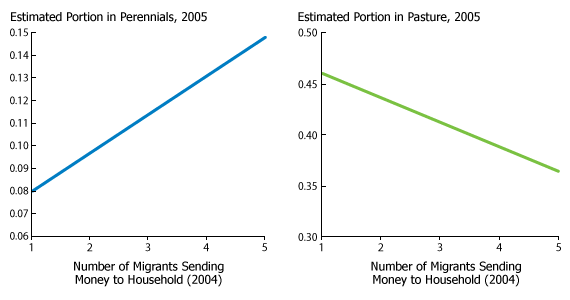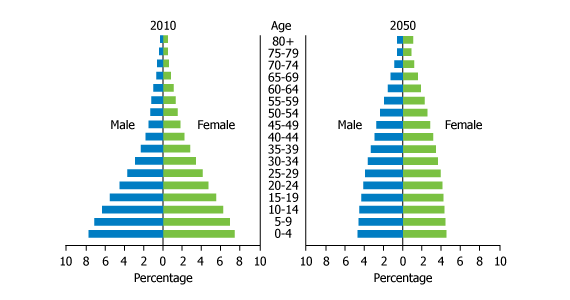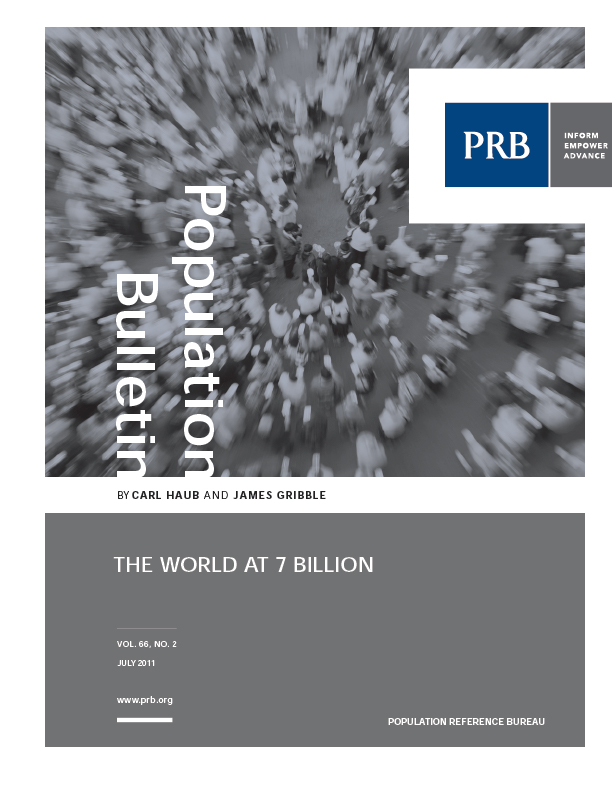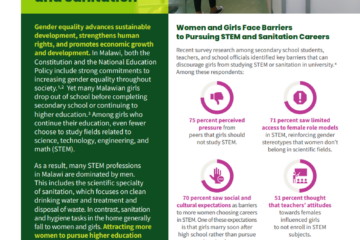
Rural Migrant Remittances May Protect Forests
Date
February 8, 2012
Author
(February 2012) Sprawling urban areas most obviously demonstrate the environmental impact of migration. Water scarcity, pollution, and lack of adequate housing are some of the more evident impacts of urban population growth. But migration also affects the environment of the communities from which the migrants come, and may actually protect forests. Recent research in the journal Population and Environment suggests that migrant remittances (earnings sent home) often shape household decisionmaking about land use at forest edges.
Migrant remittances have become a powerful social and economic force. According to the World Bank, remittances are expected to total over $350 billion in 2011, representing three times the size of official development assistance.1 Hans Timmer, director of the Bank’s Development Prospects Group, explains, “Despite the global economic crisis that has impacted private capital flows, remittance flows to developing countries have remained resilient, posting an estimated growth of 8 percent in 2011.”
As households in developing nations seek to diversify income sources and minimize risk, migration represents a common economic strategy—remittances often are essential to meet household needs. Less obvious, however, are the environmental implications of remittances. And these environmental effects are not commonly discussed within policy circles, perhaps because research on the remittance-land use connection is only beginning to yield an overarching story. New research clearly suggests that remittances are reshaping the ways in which agricultural households manage their local environments and land holdings.
Ecuador
Clark Gray, a researcher at the University of North Carolina at Chapel Hill, has undertaken extensive fieldwork in Ecuador to examine these associations. Migration is a prominent livelihood strategy in Ecuador. Since 1990, over 1 million Ecuadorians have emigrated, and international remittances represented 6.4 percent of the nation’s 2005 GDP.
In Gray’s study area of southern Loja province, households depend mostly on maize-centered small-farm agriculture, small-scale cattle ranching, and coffee-based agroforestry which allows for shade coffee production under the forest canopy. Still, the region’s agricultural productivity is marginal, suggesting that out-migration provides better options for income. Although out-migration might be linked with declining agricultural production (due to loss of farm labor), Gray found otherwise based on a survey of approximately 400 rural households. International migrant remittances are more often used to increase farm production through hired labor as well as through enhanced fertilizer use. In fact, “a doubling of international remittances led to a 7.4 percent increase in spending on chemical inputs,” explains Gray.2 In this setting, migrant remittances can intensify agricultural production on existing land and reduce pressure to expand cropland into forests.
Brazilian Amazon
Other research on the remittance-land use connection has been undertaken in the Brazilian Amazon. Leah VanWey, a Brown University researcher, has studied land use decisionmaking among Amazonian households for decades. Her work has primarily focused on small-farm families in Altamira, Para, Brazil, initially settled in the 1970s as a result of the TransAmazon highway.3
Agricultural-based livelihood strategies characterize this region. Households plant subsistence annual food crops—manioc, beans, and rice— mostly for personal consumption. Other strategies include raising cattle for regional markets, although many years are required to create pasture from forest. Perennial cash crops, especially cacao, are also common. These cash crops, destined for international markets have the highest income return, but substantial savings or access to credit are needed to purchase sufficient seedlings. Cacao also has a long maturation time—often 10 years to peak production.
Migrants from the region tend to come from households with plentiful labor, so the loss in farm help doesn’t typically reduce agricultural production. Instead, migrant remittances encourage investment in capital-intensive perennial production, mostly cacao, in place of clearing forest for pasture (see figure). VanWey and her collaborators conclude that providing migrant income opportunities and promoting capital-intensive crops where possible “has the potential to protect forest and improve rural livelihoods.”
Property in Perennials and Pasture, by Migrants Sending Remittances

Source: Adapted from Leah K. VanWey, Gilvan R. Guedes, and Alvaro O. D’Antona, “Out-Migration and Land-Use Change in Agricultural Frontiers: Insights From the Altamira Settlement Project,” Population and Environment (online, Dec. 6, 2011).
Guatemala and Mexico
A slightly different dynamic plays out in the highlands of Guatemala. Based on ethnographic case studies in two rural communities, University of California-Santa Barbara researchers Jason Davis and David Lopez-Carr find that remittances are primarily used for new home construction and educational expenses, although hiring agricultural labor and using fertilizers are also common. In fact, although overall levels of household consumption may rise, agriculturally productive areas may actually shrink because aging parents tend to use the remittances to purchase food as a substitute for on-farm food production.4
Still, the protection or regrowth of local forest may come with a cultural cost. Scholars James P. Robson and Prateep K. Nayak argue that migration can “facilitate deep-seated change in traditional ways of life, whereby migrants (and their families) become disconnected from both resource practices and the institutions of the home (or sending) community.”5 In their rural Mexican study site, migration is associated with a decline in subsistence agriculture and an increased dependence on the marketplace for food and other necessities. In fact, their research suggests that between 50 percent and 60 percent of traditional agricultural lands have been abandoned over the past 30 to 40 years. Although such abandonment means forest regrowth, the researchers lament the loss of community and traditional natural resource management institutions.6
In absolute numbers, international migration is at an all-time high. And remittances to developing countries are expected to continue increasing at a rate of 7 percent to 8 percent annually, potentially reaching $441 billion by 2014. Although migration’s impacts may be most obvious in migrant destinations, these remittances alter socioeconomic and environmental patterns and processes in origin areas as well, but may help protect forests.7
Lori Hunter is an associate professor of sociology, Institute of Behavioral Science, Programs on Population, Environment and Society, at the University of Colorado, Boulder. She is also editor-in-chief of Population and Environment. This article is part of PRB’s CPIPR project, funded by a grant from the Eunice Kennedy Shriver National Institute of Child Health and Human Development. Hunter is liaison from the University of Colorado’s Population Center to CPIPR. Other NICHD-funded researchers who are highlighted in this article are Clark Gray, University of North Carolina, Chapel Hill; and Leah VanWey, Brown University.
References
- Sanket Mohapatra, Dilip Ratha, and Ani Silwal, Migration and Development Brief 17 (2011).
- Clark L. Gray, “Rural Out-Migration and Smallholder Agriculture in the Southern Ecuadorian Andes,” Population and Environment 30, no. 4-5 (2009): 193-217.
- Leah K. VanWey, Gilvan R. Guedes, and Alvaro O. D’Antona, “Out-Migration and Land-Use Change in Agricultural Frontiers: Insights From the Altamira Settlement Project,” Population and Environment (online, Dec. 6, 2011).
- Jason Davis and David Lopez-Carr, “The Effects of Migrant Remittances on Population-Environment Dynamics in Migrant Origin Areas: International Migration, Fertility, and Consumption in Highland Guatemala,” Population and Environment 32, no. 4-5 (2010): 216-37.
- James P. Robson and Pareet K. Nayak, “Rural Out-Migration and Resource Dependent Communities: Lessons From Mexico and India,” Population and Environment 32, no. 4-5 (2010): 263-84.
- James P. Robson and Fikret Berkes, “Exploring Some of the Myths of Land Use Change: Can Rural to Urban Migration Drive Declines in Biodiversity?” Global Environmental Change 21, no. 3 (2011): 844-54.
- For more information, see: Clark L. Gray, “Gender, Natural Capital, and Migration in the Southern Ecuadorian Andes,” Environment and Planning 42, no. 3 (2010): 678-96; Eric F. Lambin and Patrick Meyfroidt, “Global Land Use Change, Economic Globalization, and the Looming Land Scarcity,” Proceedings of the National Academies of Sciences of the United States of America (PNAS) 108, no. 9 (2011): 3465-72; Philip Martin, “Remittances and the Recession’s Effects on International Migration” (2011), accessed at www.prb.org/Articles/2011/international-migration-recession-remittances.aspx, on Jan. 30, 2012; and Population Reference Bureau, “Human Population: Migration” (2009), on Jan. 30, 2012.

Guatemala: Beyond the Early Phase of the Transition
Date
July 15, 2011
Author
PRB
This article is taken from the Population Bulletin:The World At 7 Billion, which looks at the four phases of the demographic transition as descriptive of past and future population growth. Four countries are highlighted to illustrate each phase and its implications for human well-being.
(July 2011) As a lower middle-income country, Guatemala is well-advanced in its demographic transition, showing evidence of recent reductions in its birth rate.
Guatemala’s population structure illustrates that women have been having fewer children for several years, which explains why the base of the pyramid is shorter, compared to the elongated base of Uganda’s pyramid. With half of its population age 19 or younger, Guatemala’s population is still relatively young and is the youngest in Latin America. Guatemala is one of many countries in this second phase of the demographic transition; together they represent about 7 percent of the world’s population of 7 billion.
Overview
At more than 14 million, Guatemala is the most populous country in Central America. Its growth rate is still high at 2.5 percent per year—the highest in all of Latin America. Although Guatemala has several national policies that support social development and address population issues, they have not been carried out very effectively. The country has experienced economic growth in the past decade, although growth has recently slowed. Guatemala remains challenged by high levels of inequality, especially between the Mayan population, which represents approximately 40 percent of the country’s population, and the ladino population, which makes up the majority of the remaining 60 percent.
Guatemala has made great strides in addressing many of its gender-based disparities. However, the more-telling difference is between the quality of the lives of Mayan and ladina women, reflected in differences in school attendance and use of health services. Women are having smaller families; people are healthier and living longer, with a life expectancy at birth of 71 years; and the child dependency ratio is decreasing, suggesting that families may be poised to invest more in health, education, and savings. Nevertheless, sustaining economic growth and dealing with an upturn in violent crime threaten Guatemala’s longer-term development.
Age and Sex Structure of Guatemala, 2010 and 2050

Source: United Nations Population Division, World Population Prospects: The 2010 Revision (2011).
Population and Policies
Over the past 20 years, fertility levels have decreased substantially in Guatemala. From 5.6 children per woman in 1987, the recent 2008/09 National Survey of Maternal and Child Health (NSMCH) indicates that women have an average of 3.6 children each. If current fertility remains unchanged, Guatemala’s population will double in 26 years. Although fertility has gone down, women indicated that, on average, they want fewer than three children.
The recent reductions in fertility are due largely to increased use of family planning. Currently, 44 percent of married women use a modern family planning method, with female sterilization and injectable contraceptives the most common types. At the same time, an additional 31 percent of married women want to postpone or avoid pregnancy but are not using an effective contraceptive method.
Since 2002, Guatemala has had a national Social Development and Population policy that prioritizes as health objectives a reduction in maternal and infant mortality, sexually transmitted infections, and HIV/AIDS. In 2010, the Guatemalan Congress approved a law to support healthy motherhood, and stipulates that at least 30 percent of taxes on the sale of alcohol should be used to support reproductive health programs. Guatemala is also addressing poverty reduction through Mi Familia Progresa, a conditional cash transfer program established in 2008 that encourages the use of health services and education.
Economic Inequalities
Guatemala’s recent economic growth has resulted from tourism and the exports of textiles, clothing, and agricultural crops. Half of the labor force works in agriculture. Almost a quarter of the population lives on less that US$2 per day. The country has a very inequitable income distribution: The wealthiest 20 percent (quintile) of the population holds 58 percent of total income, while the poorest quintile holds only 3 percent.
Economic inequalities influence many social behaviors. Wealthier women have fewer children on average during their lives than poorer women have: 1.8 children per woman in the wealthiest quintile compared to 5.7 children per woman in the poorest quintile. It is not surprising that use of family planning methods is very high among married women in the wealthiest quintile—72 percent—but only 36 percent of married women in the lowest quintile use any form of family planning.
Gender Inequalities
Compared with many other countries, Guatemala has moved closer toward gender equality. Between 1987 and 2008/09, the percentage of women who never attended school dropped from 38 percent to 20 percent; among Mayan women, this improvement was even more notable: from 67 percent never attending school in 1987 to 35 percent not attending school in 2008/09. Recent educational advances are fairly equal for both boys and girls. Among children ages 5 to 14, there are no differences in the age at which boys and girls start school nor in the percentage who never attend school.
Gender roles also influence social behaviors and attitudes. Many Guatemalan women tend to have more traditional views. For example, 65 percent of women included in the 2008/09 survey reported that a woman should obey her husband even when she does not agree with him. Almost 80 percent responded that they need to get his approval before incurring a household expense, working outside the house, going to the doctor when ill, or leaving the house. However, only 56 percent indicated that a woman should seek the man’s approval about using family planning. Each of these attitudes was more frequently held by women in the poorer quintiles than in the wealthier ones.
Gender-based violence is not unusual, as 46 percent of women reported that they have experienced either verbal, physical, or sexual violence from their husband or partner. The frequency of these behaviors is consistent between Mayan and ladina women, as well as across wealth quintiles. However, in contrast to other countries where women accept wife beating, only 7 percent of Guatemalan women agreed that under certain circumstances a man is justified in hitting his wife.
Health of Women and Children
As a country with improving access to and use of health services, Guatemala still has a high maternal mortality ratio of 110 deaths per 100,000 live births, putting it slightly above other countries in Central America. Use of antenatal care is very high, with 93 percent of women receiving care at some time during their most recent pregnancy. More than 50 percent of women receive care from a physician or nurse during delivery, but only 30 percent of Mayan women receive skilled care, compared to 70 percent of ladina women.
Deaths among children under age 5 continue to decrease, from 109 in 1987 to 42 in 2008/09. More than half of infant deaths (17 out of 30 deaths per 1,000 live births) occur in the neonatal period; death at this phase can be prevented through skilled attendance at deliveries and antenatal care. Almost half of all children between ages 3 months and 59 months are stunted (low height for age.) However, almost twice as many Mayan children are stunted as are ladino children (66 percent vs. 36 percent, respectively). Just under half (48 percent) of children ages 6 months to 59 months are anemic, but this condition is fairly evenly distributed across wealth quintiles and ethnicity groups.
Challenges
Guatemala has made great advances in social and economic development in the past two decades, but serious inequities still exist between the Mayan and ladino populations. Regardless of the issue considered—fertility, child health, education—the disparities between these two segments of the population represent the gap that must be addressed through future development initiatives. If Guatemala follows the medium projection scenario, it will have a population of almost 32 million by 2050, and an age structure similar to Phase-3 countries.
Previous: Phase 1: Uganda: At the Beginning of a Transition
Next: Phase 3: India: On the Path to Replacement?

Maternal Mortality in Guatemala: A Preventable Tragedy
Date
June 9, 2003
Author
PRB
(June 2003) From instituting new maternal health policies to addressing the quality of health services for pregnant women and their newborns, Guatemala is taking a number of steps to try to reduce deaths and disability related to pregnancy, delivery, and postpartum complications. In 2000, 651 women died from these causes and many more were injured. In other words, two women died from pregnancy-related causes every day in this Central American nation of 12 million people, where the total fertility rate is estimated at roughly five children per woman.1
Estimates from the latest Baseline Maternal Mortality study show that 153 women die from maternity-related complications for every 100,000 live births. The region with the most dire situation is sub-Saharan Africa, where one in every 13 women risks dying of pregnancy-related causes during her lifetime, compared with 1 in more than 4,000 in industrialized countries (see Table 1). More than a social and health problem, a mother’s death is a family tragedy.
Table 1
Women’s Lifetime Risk of Death From Pregnancy, 1995
| Region | Lifetime Risk of Death |
|---|---|
| Sub-Saharan Africa | 1 in 13 |
| South Asia | 1 in 54 |
| Middle East and North Africa | 1 in 55 |
| Latin America and the Caribbean | 1 in 157 |
| East Asia/Pacific | 1 in 283 |
| Central East Europe/Commonwealth of Independent States and Baltic States | 1 in 797 |
| Industrialized countries | 1 in 4,085 |
Source: World Health Organization (WHO), United Nations Children’s Fund (UNICEF), and United Nations Population Fund (UNFPA), Maternal Mortality in 1995: Estimates developed by WHO, UNICEF and UNFPA (2001).
The Situation for Guatemalan Women Today
“Maternal mortality is an indication of the extreme harm some women suffer during their reproductive lives, the low availability and quality of health services, poor social conditions, malnutrition, and the consequences of women’s marginalized status,”2 according to the 1995 Demographic and Health Survey for Guatemala. These women generally die at home and have little access to skilled health care.3 Maternal mortality affects women from all economic and social strata, but a disproportionate number of those affected live in poverty, have little education, and live in rural areas.4 In Guatemala, the majority of deaths are among indigenous women with little education, women who work at home, and women who have two or more children.
Indigenous women have the most precarious living conditions, the highest fertility rates, and the smallest percentage of births attended by doctors or nurses (see Table 2). The maternal mortality ratio for this group is three times higher (211 per 100,000 live births) than for the nonindigenous group (70 per 100,000 live births), according to the Baseline Maternal Mortality study for 2000. Nationally, the departments where maternal mortality is above the national average are Alta Verapaz and Petén (north region), Sololá and Totonicapán (southwest), Huehuetenango and El Quiché (northwest), and Izabal (northeast).
Table 2
Percentage of Births Attended by Doctors or Nurses, Guatemala
| 1987 | 1995 | 1998-1999 | |
|---|---|---|---|
| All women | 34 | 35 | 41 |
| Indígena | 16 | 12 | 17 |
| Ladina | 48 | 52 | 55 |
Note: “Indígena” refers to women following a traditional, indigenous lifestyle. Ladina women are of any race and live a “Western” lifestyle.
Sources: Encuesta Nacional de Salud Materno Infantil 1987, 1995, 1998-1999.
More than half of maternal deaths are due to excessive bleeding. Others are due to infections, hypertension induced by pregnancy, and to unsafe abortion.5 (Abortion is illegal in Guatemala.) The Baseline Maternal Mortality study shows, among other things, that the majority of maternal deaths occur at home.
Government Actions To Address Maternal Mortality
To address these issues, the Guatemalan Congress enacted the Social Development Act in October 2001. The act establishes that the lives and health of mothers and children are a matter of public welfare and that healthy maternity is a national priority.6 The act calls for the creation of health care units capable of handling obstetric emergencies to be located at strategic sites throughout the country, particularly in places with the highest levels of maternal and child deaths.
The Population and Social Development Policy created to comply with the act aims to achieve an initial 15 percent reduction in maternal mortality.7 The body responsible for achieving this goal as well as other health advances — the National Reproductive Health Program — identifies high maternal mortality as one of the most important issues in the country. However, meeting the objective requires a strategy that involves not only the health sector but also various local and international bodies already working in the Maternal Health Monitoring Group.
One of the most recent achievements of the National Reproductive Health Program is the Baseline Maternal Mortality Study, conducted with UN agencies, governmental and nongovernmental organizations, and local universities brought together under the Maternal and Neonatal Health Monitoring Group.8 The study responded to the need to establish a real baseline for measuring the impact of actions taken to reduce maternal mortality.
The recommendations that emerged from the baseline study and which are in “Strategic Guidelines for Reducing Maternal Mortality” are meant to coordinate institutional and social efforts for an integrated response to maternal mortality. They take into account the many causes of the problem and the gender, ethnic, social, and cultural issues women face.
The National Reproductive Health Program has also produced a manual that standardizes the provision of health services at all levels of care.9 It discusses community, family, and user participation, and incorporates the concept of comprehensive reproductive health. This publication is supplemented by protocols intended to “standardize basic diagnostic and therapeutic procedures allowing institutional personnel to provide efficient, quality care to people who need the services.”10
Support From the Maternal and Neonatal Health Project
In Guatemala, the Maternal and Neonatal Health (MNH) project supports the government in promoting practices and services vital to the survival of the mother and newborn. All of its activities are coordinated with the Health Quality Project, headed by the University Research Corporation and a number of partners, with technical assistance from the U.S. Agency for International Development (USAID).11
At the heart of the MNH strategy is an accreditation program for maternal and neonatal health service networks called CaliRed (or “QualiNetwork”). This program is implemented through a performance and quality improvement approach for achieving desired institutional and individual performance. This approach provides the framework and tools to implement, measure, and evaluate improvements at facilities that deliver essential maternal and newborn health care services.
Setting Standards for Care
The criteria for measuring quality at the network of facilities (including health posts, health centers, and district hospitals) are the basis for the accreditation process. The community-defined quality dimensions include the following:
- Access to a maternity facility in the community;
- Treatment that is delivered in a respectful and timely fashion;
- Respect for traditional practices and use of indigenous languages; and
- A clean and well-equipped facility; transportation; and free services.12
The first step is to use the criteria to collect baseline measures of facility quality. This information is used to establish which are interventions to ensure improvements in the facilities, with the goal of accreditation. Each facility is reassessed after six to nine months to note improvements; if it achieves a satisfactory percentage of the criteria for quality, it receives official accreditation as a quality site for essential maternal and newborn care. When enough district facilities meet the quality standards, accreditation is awarded to the whole health services network of that district.13
As of December 2002, the accreditation process was underway at 153 health facilities, 12 hospitals, 41 health centers, and 125 health outposts.14 In 143 health facilities, new clinical practices were introduced in delivery, postpartum, and newborn care, while nursing schools received teaching support with a new focus on basic skills. Furthermore, communities are receiving municipal support to upgrade obstetric and neonatal emergency services.15
The National Postabortion Care Plan, put in place two years ago by the Epidemiological Research Center in Sexual and Reproductive Health (CIESAR), provides another channel for reducing maternal mortality. A diagnostic study was also done by CIESAR; the study is the first of three parts of a strategic approach developed by the World Health Organization to improve access to and quality of basic services in sexual and reproductive health. The first stage focuses on arriving at a strategic diagnosis of the current situation and planning specific actions. The emphasis is also on developing recommendations for changing or modifying current health policies, programs, and interventions, and identifying research needs. The emphasis of the second stage will be research and action. The most significant recommendations developed during the first stage are tested and evaluated for the design of health interventions. During the third stage, these interventions will be replicated and implemented on a larger scale.
Nancí Franco de Méndez is a population, health, and media specialist, based in Guatemala.
References
- Ministerio de Salud Pública y Asistencia Social (MSPAS), Línea basal de mortalidad materna para el año 2000 (Guatemala City: MSPAS, 2003).
- Instituto Nacional de Estadística (INE) et al., Encuesta Nacional de Salud Materno Infantil 1995 (Guatemala City: INE, 1995).
- MSPAS, Línea basal de mortalidad materna para el año 2000.
- Pan American Health Organization (PAHO), Regional Strategy for Maternal Mortality and Morbidity Reduction (Washington, DC: PAHO, 2002), accessed online at www.paho.org/english/gov/ce/spp/spp36-08-e.pdf, on March 10, 2003.
- MSPAS, Línea basal de mortalidad materna para el año 2000.
- Ley de Desarrollo Social, article 26, no. 5 (Guatemala City: October 2001).
- Secretaría de Planificación y Programación de la Presidencia (SEGEPLAN), Política de desarrollo social y población (Guatemala City: SEGEPLAN, April 2002).
- The organizations brought together under the Maternal and Neonatal Health Monitoring Group include the Ministry of Public Health and Social Welfare (MSPAS), the National Reproductive Health Program (PNSR), the Health Information Management System (SIGSA), Support for Health Sector Reform–European Union, the Epidemiological Research Center in Sexual and Reproductive Health (CIESAR), Johns Hopkins Project for International Education in Gynecology and Obstetrics/Maternal and Neonatal Health (JHPIEGO/MNH), United Nations Mission in Guatemala, PAHO, United Nations Children’s Fund (UNICEF), USAID, Secretaría Presidencial de la Mujer (SEPREM), Medical Entomology Research and Training Unit of the Universidad del Valle/CDC, United Nations Population Fund (UNFPA), University Research Corporation, National Office on Women, Guatemalan Gynecology and Obstetrics Association, Universidad Rafael Landívar, Universidad del Valle de Guatemala, Universidad de San Carlos, and the World Health Organization.
- PNSR, Lineamientos y normas de salud reproductiva, a publication of the PNSR with support of the Canadian government and UNFPA.
- MSPAS, Protocolos de salud reproductiva (Guatemala City: MSPAS, January 2003).
- Maternal and Neonatal Health Program, “Guatemala Ministerial Agreement Will Scale Up Performance and Quality Improvement Initiative,” NMH News (February 2002), accessed online at www.mnh.jhpiego.org/news/gtmoh.asp, on April 23, 2003.
- Maternal and Neonatal Health Program, “Country Profiles: Guatemala,” accessed online at www.mnh.jhpiego.org/where/guatemala1.asp, on April 23, 2003.
- Maternal and Neonatal Health Program, “Guatemala Ministerial Agreement Will Scale Up Performance and Quality Improvement Initiative.”
- Information supplied by USAID on advances in national formative and operative policy for pregnancy, childbirth, postpartum, and newborn care.
- Information provided by the Maternal and Neonatal Health Program, JHPIEGO Corporation, Guatemala.
For more on maternal mortality in the developing world, read PRB’s report Making Motherhood Safer: Overcoming Obstacles on the Pathway to Care (PDF: 734KB).

 ">
">









